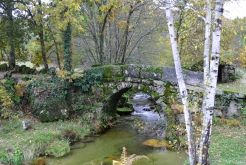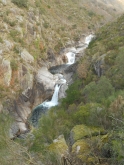VEGETATION
At first sight, this is a land of fields, meadows and uncultivated grounds as well as of extensive cattle farming. The grandeur and uniqueness of the area has to be found in the vast open spaces and in the huge volumes and shapes of the massifs of granite.
There are no so many forests; however, there are several groves. It is precisely in the river banks of rivers Laboreiro and Troncoso, where, some forested areas can be found sheltered by the towering massifs.
The most significant forests are the Laboreiro river, right at the confluence with the river of A Peneda, and also on the bank of Olelo (Entrimo), where there are great oak forests, typical of the so called Galician-Portuguese sector.In the lower areas, on the same banks of the two rivers, strawberry trees, laurels and even olives can be seen, together with Mediterranean cork oaks and white sandalwoods. Along with all the above, with a lot of natural variety, there are many other species, such as white maple trees, “arraclanes”, cherry trees, elms, chestnuts, birches and especially hazelnut trees.
Beside the trees described, we can also observe an abundance of bushes and flowers. Many of these species, such as gorses, brooms, white heathers, “quiruelas”, argonnes and blond heathers, grow in areas that were declared priority areas or areas of community importance in the European Directive 92/43/CEE, in such a way that, for the whole of the current International Biosphere Reserves, declared in 2009, a total of 29 types of habitats were detected, and six of them were considered priorities, like for example, the peat lands that grow in the Planalto.
In these areas, there are also unique species of great botanical and environmental interest, such as Drosera carnivorous plants, cotton grass, “arnica” and water clovers. At the top of the massifs surrounding the rivers, where the first freshwater springs are born, visitors can admire natural jewels like love herbs, daffodils, lilies and beautiful and rare species such as ris boissieri, Centaurea limbata subsp. Gerensis, Silene acutifolia or Eryngium juressianum.
Thus, behind the raw and naked appearance of these landscapes, lies a vast, splendid and surprising variety of life.
FAUNA
A study of the International Biosphere Reserve, where this territory is located, indicates the existence of 268 species of vertebrates. 204 of them are protected by national and international regulations, while 71 are included in the red list of threatened species.
In these territories there are large mammals such as otters that live in almost all the pristine waters of the streams that flow into the Laboreiro and Troncoso rivers. Wild boars, foxes, badgers, weasels, sables and wild cats also roam these lonely areas. However, one of the most important mammals is the elusive wolf that moves through the massifs. Finally, along with the aforementioned animals, the wild goat also can be found grazing here.
Visitors may be surprised to witness the majestic flight of the golden eagles, as well as other birds of prey like goshawks, sparrow hawks and buzzards. In the area there are many other birds, some of them hard to find elsewhere, such as choughs, crossbills, blond and blue blackbirds, red-backed shrikes, yellowhammers and peregrine falcons, together with owls and barn owls.
Nonetheless, the queen of the Laboreiro and Troncoso rivers is the trout, since these waters are a paradise for the native trout (Salmo trutta fario), known as the “pintona”, which seeks out the purest waters.








